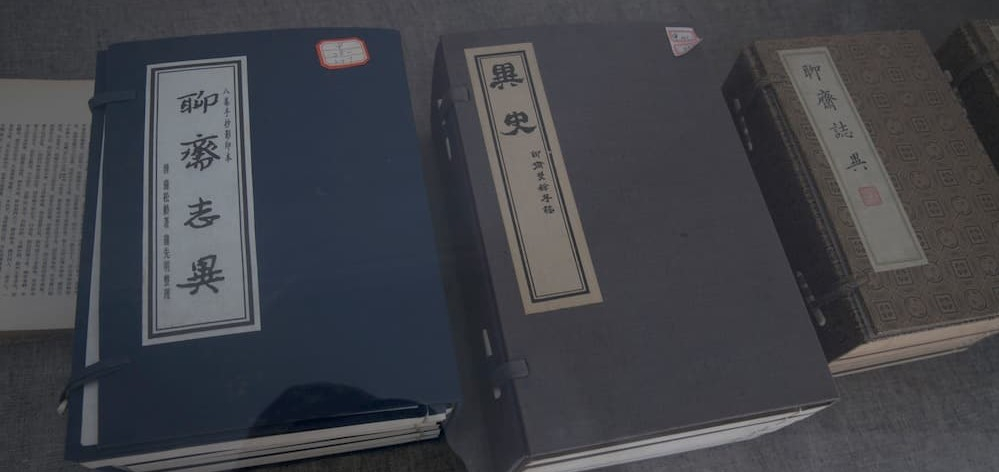
Strange Tales from the Idle Studio
Splendid
Chi Culture
Topic
Strange Tales from the Idle Studio
Strange Tales from the Idle Studio (also translated as Strange Tales from a Chinese Studio), Liaozhai zhiyi, or Liaozhai, is a collection of short stories compiled by the Qing dynasty scholar Pu Songling. By telling stories about fox spirits, ghosts, transcendents, and demons, he successfully portrays a great number of archetypes. With its lively characters, intricate plots, and careful composition, the book harshly criticizes the dark side of society.
Pu Songling (1640–1715), whose courtesy name was Liuxian, was born into a scholarly family at Zichuan, Shandong. When he was nineteen years old, he sat for the civil service examination and ranked first in each of the three stages of the exams: county, prefecture, and sub-provincial. As a result, he became famous in his hometown, but, afterwards, he failed for decades to pass the exam for the title of juren (literally “recommended man,” a title given to those who passed the triennial provincial exam). This understandably frustrated him. In his thirties, Pu Songling went to Baoying, Jiangsu and became a private secretary for a short period of time. While in this position, he learned the social customs of the Jiangnan (literally “south of the Yangtze River”) area, was privy to the inner workings of the local bureaucracy, and interacted with some open-minded women; all the while accumulating rich subject matter. Throughout his life, Pu Songling was a Ruist and ideas of benevolence learned from Confucius and Mencius dominate Liaozhai. Ruist morality is Pu Songling’s criterion when satirizing the ways of the world.
Although Liaozhai uses a large number of folktales as the basis for its stories, most of the representative works, however, were written by Pu Songling himself. He not only extended the length of traditional short stories, but also significantly updated the themes, styles and forms. The stories in Liaozhai can be divided into two categories based on form. The first category contains those stories that are heirs to the tradition of biji (notebook) fictions which recorded legends in short texts. The second category are those that follow the tradition of chuanqi (literally “transmission of the strange”), which were of greater length and might exist in more than one version, each written by a different author. Five main themes are present in the novel. The first theme is an admiration of love between young men and women. Many heroines in the book are not human beings and scholars who fall in love with them are seen as affectionate eccentrics. Those stories eulogize love as part of human nature. The second theme is the exposure of society’s underbelly. The book uses the supernatural and the uncanny to illustrate corruption and cruelty in society. The third theme is the fraudulence of the examination system. Pu Songling postulated that many examiners were stupid and greedy while a lot of students were intellectually stunted. Fourth, he criticized social customs. He could write in a variety of styles including allegorical, documentary, mythical, and realistic. The last category are accounts of the uncanny, and include stories about ghosts and other supernatural creatures, notable fox spirits, as well as real occurrences. Apart from faithfully recording the legends and customs, he also embedded his own thoughts and artistic imagination into them.
Great artistic skill can be seen in the way Pu Songling not only combined myths and reality but also in the manner he incorporated detailed historical facts into the various stories about ghosts and fox spirits. Although he was depicting the “strange,” he was able to show the real world. The work has a romantic flavor, especially the love stories with their supernatural elements and extraordinary characters. In Liaozhai the composition of the stories is emphasized. The number of unique images is limitless, and the plots are intricate and suspenseful. Liaozhai is also known for the style of its language. Its descriptive techniques are unprecedented in Chinese belles lettres and unmatched. Pu Songling borrows from Sima Qian (ca. 145–ca. 90 BCE) a technique that allows him comment on the characters in order to critique social customs. In the Shi ji (Records of the historian), Sima Qian began his comments with the formulaic phrase “The Historian says.” Pu Songling introduces his comments with “the Historian of the Strange says.”
Liaozhai is not only a classic of traditional Chinese literature, it is the pinnacle of pre-modern fiction written in classical Chinese (as opposed to vernacular Chinese). Many have spoken highly of this work, from the famous Qing scholar Wang Shizhen (1634–1711) to the world renowned author Lu Xun (1881–1936). Liaozhai was published more than 300 years ago but its popularity continues to grow. Shortly after it was written, it circulated in manuscript copies, and as its popularity grew these were followed by printed facsimiles, then edited editions, versions with commentary and, finally, editions in vernacular Chinese. There have also been countless theater, film, and TV adaptations. By the end of the last century, Liaozhai had been translated into more than twenty languages.



